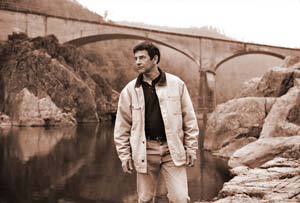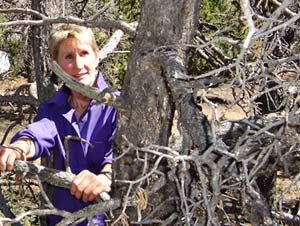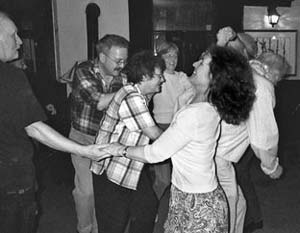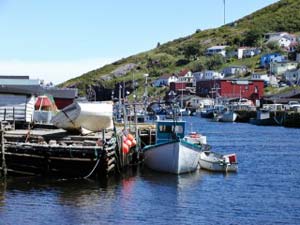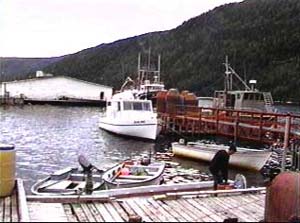August 12, 2005
Air Date: August 12, 2005
FULL SHOW
SEGMENTS
Targeting Genes to Understand Behavior
/ Sheri QuinnView the page for this story
Physical attributes like hair color and skin tone can be traced to the expression of certain genes in our DNA. But, what about behavior? As reporter Sheri Quinn finds, researchers at the University of Utah may have discovered a genetic link to obsessive compulsive disorder. (09:00)
Living Toxic
/ Katherine MieszkowskiView the page for this story
Katherine Mieszkowski, a senior writer at the online magazine, Salon dot com, explains why her body has become a toxic waste site. (03:40)
Nature Noir
View the page for this story
When Jordan Fisher Smith first became a park ranger; he was motivated by the teachings of Thoreau and the ideals of the park system. Little did he imagine the park he would patrol for 14 years would be a virtual Wild West, where miners and guns, not hikers and backpacks, were the norm. Host Steve Curwood talks with Fisher Smith about his new memoirs, Nature Noir: A Park Ranger's Patrol in the Sierra. (09:00)
Beetle Mania
/ Paul InglesView the page for this story
A sound artist in New Mexico has devised a unique way to save drought ridden pinon trees from falling under attack from the bark beetle. David Dunn listens to the tree to see if it's infested. Paul Ingles reports. (08:00)
Emerging Science Note/Eye-Catching
/ Max ThelanderView the page for this story
Living on Earth's Max Thelander reports on a study that finds exactly what's going on in the very eye of a hurricane for the first time. (01:20)
Life After Cod
/ Chris BrookesView the page for this story
A rare look from inside a community that has lost its longtime reason for being. Newfoundland producer Chris Brookes listens to what was lost and what has remained in two communities since the disastrous over-fishing of the region’s Atlantic cod. (15:30)
This week's EarthEar selection
listen /
download
Show Credits and Funders
Show Transcript
HOST: Steve Curwood
GUESTS: Katherine Mieszkowski, Jordan Fisher Smith
REPORTER: Sherri Quinn, Paul Ingles, Chris Brookes
NOTE: Max Thelander
[THEME MUSIC]
CURWOOD: From NPR, this is Living on Earth.
[THEME MUSIC]
CURWOOD: I'm Steve Curwood. For as long as anyone can remember, cod was king in the Canadian Maritime province of Newfoundland. Then, about a dozen years ago, the fishery collapsed, taking with it thirty thousand jobs and a way of life. Many people left the island. Others stayed to make a living through tourism, but now wonder if they’re selling out their heritage.
KIERLEY: You can get all nationalistic about it, and say, well, Newfoundland is not for sale. Go home, filthy tourist maggots. This is ours. It’s not a souvenir. And there’s a lot of people who are like that.
CURWOOD: But not all. Other islanders say: adapt or die.
MAN: We had fish one time. We had employment. We got tourists now. We’re fishers of people basically now, rather than fishers of cod.
CURWOOD: Life after cod, and more – this week on Living on Earth. Stick around.
[MUSIC UP AND OUT]
[NPR NEWSCAST]
ANNOUNCER: Support for Living on Earth comes from the National Science Foundation and Stonyfield Farm.
Targeting Genes to Understand Behavior

Dr. Mario Capecchi developed the revolutionary technique of gene targeting. (Photo: Courtesy of Eccles Institute of Human Genetics)
CURWOOD: From the Jennifer and Ted Stanley Studios in Somerville, Massachusetts, I’m Steve Curwood with an encore edition of Living on Earth. Short or tall. Dark or light. Male or female. Just about everything physical that distinguishes one human being from another is determined by our genes. Our genetic code is so complex that if it were stretched out in a single line, the DNA that makes up our genes would reach the sun and back hundreds of times. But our DNA is actually in more of a tangle, and it once seemed impossible to pick out a single strand, let alone discover its role. But in the late 1980s, geneticist Mario Capecchi developed a technique called gene targeting that lets scientists find specific genes and change them within living mice. And now researchers at the University of Utah using this technique have engineered a mouse that may help us understand how genes may be directly linked to certain human behaviors. Sheri Quinn has our report from Salt Lake City.
QUINN: Christina Pearson is paying close attention to a certain group of genetically engineered mice at the University of Utah. She believes discoveries recently made there might change her life.
PEARSON: When I would pull my hair I would feel for a certain texture, I would feel for a certain sensation, a certain type of hair and then when I found the one that worked, it was if I had found gold and my nervous system would just light up.
QUINN: Pearson has trichotillomania. It’s part of a spectrum that includes obsessive compulsive disorder, or OCD. Those afflicted are obsessed with pulling their hair out. But Pearson thinks this behavior is part of her inner core, locked into every cell of her body.
PEARSON: The urge to pull my hair was as strong as the urge to breathe. It felt like if I didn’t pull my hair that I was suffocating. It was as if I was in a pool of water drowning, and struggling for air. I tried drinking myself into black outs because I found if I could black out and fall asleep, I wouldn’t pull my hair. If we could develop an animal model it might helps us make sense and come up with treatments for human beings so they don’t have to go through the 30 years of hell that I went through.
QUINN: Researchers at the University of Utah might just have such a model. But in order to understand why this work is happening here, we have to understand the work of a World War II refugee who became an American scientist. Mario Capecchi was born in Verona, Italy in 1937. When he was four, his mother was sent to the concentration camp Dachau for posting anti-fascist pamphlets. Capecchi survived by begging and stealing. Hunger, he says, helped form him.
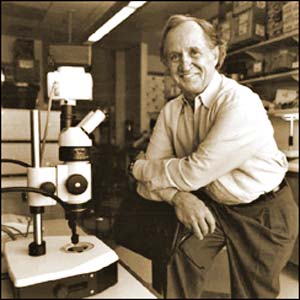
Dr. Mario Capecchi developed the revolutionary technique of gene targeting. (Courtesy of Eccles Institute of Human Genetics)
CAPECCHI: If you are going to survive, things aren't going to work out every time. You go after a certain source of food and sometimes things don’t work out and you don't get food that time and so then you have to persist and try and try again. You have to set your own inner determination to be able to go after things and that's sort of a doggedness that is important also for survival.
QUINN: Capecchi's mother was released from Dachau five years later. She searched for her now nine-year old son for over a year and found him ill with typhoid in an orphanage hospital. A few days later she brought him to the United States and Capecchi began to thrive. He grew up on a Quaker commune then went to Harvard where he eventually came to know the famous biologist James Watson, the man who together with Francis Crick had discovered the structure of DNA.
CAPECCHI: If you work in a field where lots and lots of people are working in that particular area then it does not make a big difference whether you do it or you don’t do it. That science will be done. And I’d rather work on something that I feel I can uniquely contribute to.
QUINN: Capecchi taught at Harvard Medical School. But in 1973, he moved to the University of Utah. Colleagues thought he was crazy to leave Harvard. But the University of Utah had begun to build a reputation as a goldmine for human geneticists, thanks to the Church of Jesus Christ of Latter Day Saints, or Mormon Church, which keeps detailed genealogical records of its large families. At the University of Utah Capecchi spent a decade developing gene targeting. Scientists already knew how to insert altered DNA into cells. But out of thousands of cells, typically only a few will incorporate that altered DNA. The challenge was to identify which ones.
CAPECCHI: And so, if that could happen then that would allow us essentially the ability to change any gene we wanted in any way conceivable.
QUINN: Bob Horvitz is a Nobel- winning MIT biologist who is well acquainted with Capecchi’s work.
HORVITZ: With Mario there is now a technology that allows the analysis of any gene in the genome. And it is the difference between night and day. No, it is much more than that. It’s truly a revolution. It has led to kinds of experimentation that would have been unthinkable not very many years ago.
[SCRATCHY, SCREECHY SOUND]
QUINN: This is the sound of a tiny mouse embryo, the size of a grain of rice. Once scientists see which mouse cells have taken up the new gene, they place them into an embryo that will continue to grow into a mouse. They are called knockout mice because a gene has been knocked out and replaced. With a bit of luck, when they grow up, some of these knock out mice will transmit the new gene to their offspring.
[METAL SOUNDS]
QUINN: Capecchi’s 13-thousand mice are kept in a facility called the mouse house. They're cared for by a crew of biologists, former veterinary techs and pet store workers. Fred Beasley and Adine Marston often witness strange grooming behavior, and they too wonder what the research could reveal about ourselves.
FRED: Some mice like to groom themselves in interesting ways, make neat little patterns on their fur.
JUNE: Uh-huh. I had a cage where 11 other mice had a little rainbow shape above their left eye, every single one of them except for the one that was doing the grooming.
QUINN: Watching mice grooming, it’s hard to imagine that a single gene could control such a complex behavior. But geneticist Joy Greer, a former graduate student in Capecchi’s lab, replaced a normal copy of a gene called HOXB8 with a defective one. She was expecting to study limb deformities. Instead, she noticed the mice started grooming to the extreme. They stayed awake to do it. It looked to her like a form of OCD, obsessive compulsive disorder.
GREER: Oh, it was totally unexpected. Basically, I noticed that these mice had these huge bald patches and I had to find out why and while I was analyzing the video tapes it became very clear that what was happening was that the mice were removing their hair while they were grooming themselves.
QUINN: HOXB8 is a member of a large family of genes, collectively called the HOX genes which are mostly known for their role in designing the general body plan from flies to humans. So finding that a HOX gene could be involved in a behavior was a thrilling discovery.
GREER: And this, as far as I’m aware, is the only HOX gene that has been implicated in behavior.
QUINN: It’s one thing to make comparisons between mice and humans when studying disease. But studying mouse genes to understand human behavioral disorders is new.
GREER: I think that these animals could provide a good animal model of repetitive behaviors. Whether or not it will be directly linked to OCD still remains to be seen.
QUINN: Since mice and humans have nearly identical genes, Greer and Mario Capecchi are now looking at people with the hair-pulling disorder to see if they can find the same gene defect they found in mice. It’s unclear how common trichotillomania is, but it’s not rare. It seems to cluster in families. Christina Pearson says most hair pullers aren’t aware of it in their family history.
PEARSON: The problem with a disorder like this is that if your great grandmother had trichotillomania , you probably wouldn’t know it because it’s still hard for people to talk about today.
QUINN: In the 1970s, when sufferer’s dared to seek help, doctors viewed them as psychotic. But now Christina Pearson is proud to be director of the Trichotillomania Learning Center with 32,000 hair-pulling members.
PEARSON: It is amazing the stories that I’ve heard. One father said to me he was beating his daughter with a belt and she was lying there on the floor, saying, “Daddy, it won’t help, it won’t help.” I’ve talked to the mothers of young women who have killed themselves, okay, put guns in their mouths because they could get no help.
QUINN: It's now been several years since Pearson has pulled her hair out. She uses medicine, therapy and group support to fight the urge.
Since the late 1980s, gene targeting has spread to thousands of laboratories throughout the world. Scientists use it to investigate the mechanisms that instruct a gene to make a limb or a wing, a hand or a paw, a behavior, even a memory. For Living on Earth, I’m Sheri Quinn in Salt Lake City, Utah.
Related link:
Dr. Mario Capecchi faculty info
Living Toxic
CURWOOD: High levels of mercury have been showing up in many species of seafood, and the people who eat them, including commentator Katherine Mieszkowski
MIESZKOWSKI: Too bad Superfund is bankrupt. Because I recently discovered that I am a toxic waste dump. I'm a walking, talking contamination site whose mercury pollution level exceeds federal health guidelines for a woman my age. And, depending on your taste for big carnivorous fish, like shark and albacore tuna, you too could be swimming with the stuff.
As part of a study being conducted for Greenpeace, anyone can get their mercury level tested for 25 dollars. When my own mercury test kit arrived in the mail, I enlisted a co-worker to play the role of medical assistant/hair stylist. She cut a hair sample from the back of my head close to the scalp.
I really wasn't worried. I was curious, but I don't eat that much fish. So, after I mailed the sample to a lab at the Environmental Quality Institute at the University of North Carolina-Asheville, I promptly forgot about it.
Then, a few weeks later, I found out that I am contaminated. My results came back as 1.08 micrograms of mercury per gram of hair, just over the threshold of 1 part per million that's considered safe. And I am not alone. In preliminary results, the study found that 21 percent of women in their reproductive years exhibited mercury levels that exceed federal guidelines.
I rationalized that since I'm just .08 over the limit, it isn't really that big a deal. But when I called the director of the Environmental Quality Institute, which did the testing, he told me: "If you have a level above 1, it's definitely a cause for concern."
Mercury can put a developing fetus or nursing child at risk for brain damage. Children born with high levels of mercury can have learning disabilities, lower IQ, and behavioral problems, like sluggishness. The mom need not have any symptoms whatsoever to exhibit levels that could harm a child.
The largest manmade source of mercury pollution is the coal-fired power plant, which puts the toxin squarely in the middle of energy politics. The Bush administration is poised to issue new guidelines for regulating mercury pollution in March 2005. But some environmentalists argue their proposed measures won't cut the pollution quickly enough.
If you're concerned about mercury, the EPA suggests you leave big predatory fish, like shark, swordfish and tilefish, out of your diet completely. You're also supposed to limit your intake of other fish and shellfish to about 12 ounces a week -- about two average meals. Albacore tuna is typically higher in mercury than light canned tuna, so limiting albacore to once a week is also advised. Especially recommended are salmon, catfish and shrimp, which all have "decent amounts" of omega-3 fatty acids and relatively low mercury levels.
But watchdog groups challenge the EPA's guidelines as not aggressive enough, suggesting that they subject women and their fetuses and young children to too much risk, while pandering to the fish industry.
Still, the best way for me to get my levels back down into the no-worry zone is to change the fish I eat. And the good news is I can actually get rid of some of that mercury. When people stop eating contaminated fish their levels can drop in just a few months. So, I am cutting back on those tasty carnivores, and I plan to get another test early next year. Let's hope I'm no longer toxic.
CURWOOD: Katherine Mieszkowski is a senior writer at the online magazine Salon.com.
[Andrew Bird’s Bowl of Fire “Beware” from ‘Oh! The Grandeur’ (Ryko - 1999)]
CURWOOD: Coming up: A modern day lone ranger takes on the bad guys in good lands. Keep listening to Living on Earth.
[Michael Schatz “All Full Up” from ‘Banjo Music’ (Rounder-1992)]
Nature Noir

Author Jordan Fisher Smith (Photo: Jim Herrington)
CURWOOD: It's Living on Earth. I'm Steve Curwood. Before taking up his patrol of the American River in northern California, Jordan Fisher Smith thought being a park ranger was an idyllic and rather noble calling, rooted in the theories of preservation and the spirit of Henry David Thoreau. Little did he know that the park he wound up patrolling for the next 14 years was less a destination for nature lovers and more of an escape for armed convicts, sociopaths and miners, desperate for one last strike of gold. Still, Jordan Smith and his fellow rangers stuck to their handbooks, trying to preserve the land even the federal government had written off. His book is called “Nature Noir: A Park Ranger's Patrol in the Sierra,” and he’s with us. Jordan, hello.
SMITH: I’m delighted to be with you, today.
CURWOOD: Now, as you describe in your book, you arrived at the American River of the Sierras, with an idyllic view of the kind of land that rangers were meant to protect. What did you see first when you stepped onto this territory?
SMITH: Well, I think it was the strangest park I’d ever seen. It was the inverse of what I understood as a national or state park. This area that I came into, the American River, the north and middle fork, these 48 miles of canyons, was designated by no less than the authority of the United States Congress to be drowned forever under a huge dam. The United States Bureau of Reclamation that had been the author of this dam had bought up some 42,000 acres from either willing sellers or condemned ranchers and miners and homesteaders that lived there and evicted them and eventually burned down all of the dwellings there. So, this place that had been the heart of the goldrush country was rendered back into a sort of accidental wilderness area. However, the Bureau of Reclamation doesn’t have its own land management rangers. And, during the time the dam was being built and then during the time the dam was delayed, this area was resettled by itinerant goldminers and squatters of all stripes and a good many fugitives from the law who were living in vehicles and makeshift shacks and tents all over the place. What I found there was a state of near anarchy. A good many people were armed; they pretty much did as they pleased and there were at the time when I got there, I think, five rangers trying to get by in those canyons without getting themselves killed.
CURWOOD: And, so there you are, patrolling and trying to preserve a place which by government intention is supposed to go away. What kind of person would choose to protect a place like that?
SMITH: You know, I can’t congratulate myself for ever having chosen that. I more or less arrived there by chance and I probably didn’t leave for reasons I still don’t entirely understand, but partly out of stubbornness. I thought if we couldn’t do a good job as rangers there, then what good was it.
CURWOOD: But, wait a second, it’s all going to go away. It’s all just going to get …
SMITH: Well…
CURWOOD: Swept away.
SMITH: That was our conceit as rangers. I’m using that in the literary sense. We were sent there to bring the area under control after it had essentially descended into anarchy, people were being found in shallow graves and there were sort of disputes over mining claims. They had sent in the Federal Marshals Service for occasional sweeps and that hadn’t worked. So, in 1977, the park rangers that were intended to be sent in later, when the reservoir was finished to run it as a recreational lake, were sent there, merely to get control of it. But, you have to remember that the only law book that a ranger has, is the law book that was designed to preserve these landscapes that make up most of the park system in perpetuity. So, we as rangers, just began enforcing the laws we had and treating the place as if it was a park. And, in some way, I think I knew and I think the other rangers knew that if we could just make it safe to be there, the people who could save that land would come down there and see how beautiful it was and begin working for it.
CURWOOD: So, you joined the cavalry as it were. And, at times your job seems like it could have come out of a classic western novel. I mean, there’s a point where you describe a pretty typical, but it sounds like a dangerous part of that gig which was trying to collect the camping fees from miners living in the canyons. And, I’m wondering if you could read to me from that portion of your book, please?
SMITH: I’d be happy to. “I got out and faced him from the other side of the vehicle hood where the engine block between us afforded some cover if I needed it. He looked at me warily, ‘Is there a problem?’ he asked, arriving at the jimmy. I stepped toward him to stand directly to his right within reach of his gun hand. ‘Could you please put that gun on the hood for me?’ ‘Why? Is there a problem?’ His face darkened. ‘You’ve got a gun.’ His eyes narrowed. ‘So? I haven’t done anything illegal.’ ‘You can’t carry it in this or any other state park campground,’ I replied. ‘This is a state park? No way,’ said the miner, ‘where’s the sign? I thought this was just the American River. Anyway, it’s never been a problem before.’ Beads of sweat were breaking out on my face. O’Leary was out of the jimmy now, but said nothing. ‘Look just put the gun on the hood and then we’ll talk,’ I told him. He gave me a ‘don’t you ever turn your back on me look’ then slowly unholstered the gun and clunked it down on the hot, green steel of the truck’s hood. I moved for it, swiftly but with steadied nonchalance. Once it was in my grasp, I spun the cylinder and dumped the ammunition. The gun was loaded with six 357 hollow points. The miner’s eyes bore through me. When I finished I turned my citation book toward him. ‘What the hell is this for?’ he asked. ‘I haven’t done anything wrong and I told you I’d pay you the next time you come. You don’t have to be a jerk about it.’ The man looked at O’Leary and his tone changed. ‘Hey Ron, you know us, you’ve never hassled us. Tell your rookie to leave me alone.’ ‘Just sign the ticket. It’s not my call,’ O’Leary growled back at the man through his beard and sunglasses. It was plain he wasn’t enjoying himself. I couldn’t tell if he was more irritated at the miner or at me. Turning back to the miner I continued, ‘you have been cited into Georgetown Court. Your appearance date is…’ ‘You can bet I’ll be there,' he snapped back. 'Now, give me back my gun.’
CURWOOD: So, what happened to his gun?
SMITH: Under these circumstances where the gentleman wasn’t a felon, the gun would be taken as evidence and at the time he appeared in court and was either sentenced to a fine or released. A release would be made on the gun and he would then come to the evidence custodian at the ranger station. It would be released back to him.
CURWOOD: So, did he come and get his gun?
SMITH: I believe he did, yes.
CURWOOD: But, by the time that happened, I imagine the word had gotten out about Mr. Jordan Fisher Smith, the rookie on patrol now in American Rivers Park.
|
SMITH: Well, I just did what, and it wasn’t just me, you know, it was the other rangers, too, all of us, I think, right around that time realized what a hazard we had. There was gunfire all the time on that place. You’d go out, stand in front of the ranger station and you could hear gunshots at all times of day. And, we began going out and just enforcing the park law, which was that you couldn’t carry a loaded gun in the place. And, in the next eight years there, I seized 108 weapons as evidence in these cases. CURWOOD: Why did you stay as long as you did? What, 13, 14 years? SMITH: I think there were two reasons. I think that one was that I began to see the incredible beauty of the place. This is a very interesting climate that you have on the west slope of the Sierra. It’s the place where the desert southwest meets the Douglas fir nation of the northwest. The evenings in the summer, I worked a lot of evenings, were the most sort of silky warmth, after the setting of the sun there’d be a period of blue twilight. And, I thought that if I couldn’t be a ranger there, then what good was it? I thought this was maybe something that I was meant to do. Looking back on it, I guess it was a strange form of protest against the dam. Most protests are done by breaking the law and in this case, it was a protest by enforcing the law, the law of parks in a place that was considered worthless. CURWOOD: Jordan Fisher Smith has been a park ranger for more than 20 years and is author of “Nature Noir: A Park Ranger’s Patrol in the Sierra.” Jordan, thanks for taking this time with me, today. SMITH: I really enjoyed it, Steve. Thank you. Related link: [Grey DeLisle “Joanna” from ‘Iron Flowers’ (Sugar Hill Records - 2005)] Beetle Mania
Nancy Dahl kneels by a dead piñon tree. (Photo: Paul Ingles) CURWOOD: In the drought-stricken desert of northern New Mexico, the once common piñon tree is dying at a rapid rate. The thirsty, weakened trees are falling to an aggressive attack by tiny bark beetles. Some foresters say that there’s little to be done to stop the infestation and that the die-off is actually helping to thin out some areas of forests that are dangerously overgrown. But upset property owners are looking for ways to save their piñons. Producer Paul Ingles met someone in Santa Fe who is offering them help by literally listening to the beetles’ side of the story. [CRUNCH OF NEEDLES UNDERFOOT] INGLES: Nancy Dahl walks toward a mostly barren hillside, just a few feet from her southwest-style stucco home on the outskirts of Santa Fe. [MORE CRUNCHING] DAHL: We’re now standing on what I call “piñon boot hill.” You can see lots and lots of stumps where I’ve had my trees taken out. INGLES: Dahl says she’s spent thousands of dollars over the last two years having more than 100 dead piñon trees cut down and hauled off to reduce the threat a wild fire might pose to her home. [HIGHWAY SOUNDS] INGLES: When she moved here 25 years ago from Michigan, Dahl found a quiet tree-buffered retreat. [HIGHWAY SOUNDS] INGLES: Now, the drone of the nearby highway rolls unfettered up this cleared-off hillside, right through the open windows of her home. [HIGHWAY SOUNDS, BIRDS CHIRPING] INGLES: Dahl’s view isn’t what it once was either. Across the highway, a hill of undeveloped open space – once a picturesque dense green – is now half brown with wasted piñons. The trees were killed off by the ips confuses bark beetle infestation that started midway through this region’s now four year drought. DAHL: It’s very sad. It’s very, very sad for me. Really, these are my friends. These trees were my friends. INGLES: Another friend of Dahl’s, named David Dunn, stands nearby at the edge of a grove of needleless, dead gray piñons that look like the backdrop for a Halloween play. Like me, he wears headphones and has a recording machine slung on his shoulder. But the device connected to his recorder is a microphone like none I’ve ever seen. 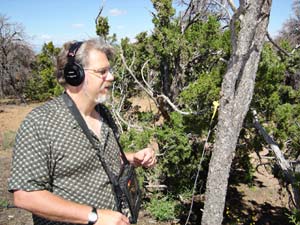 David Dunn listens for bark beetles in a piñon tree. (Photo: Paul Ingles) |
DUNN: Basically it’s a meat thermometer meets a greeting card. INGLES: A greeting card? DUNN: Some of the best of these piezoelectric transducers actually can be found inside greeting cards, particularly Hallmark make really nice ones that they use as little playback speakers. These little things work both as input and output transducers for sound. INGLES: While Dunn is becoming known for creating unusual devices for recording the quieter sounds of nature, his resume includes classical training as a violinist, composing and performing experimental music and teaching about the properties of sound. But he’s set aside most of that this year for projects that merge his sound gathering skills with the environmental sciences. DUNN: I think it is essential that at this point historically that artists take a role in collaboration with the scientific world – that artists and scientists work together towards real world problem solving. We need all the help we can get. [SOUND OF BARK] INGLES: Like a nurse administering an IV, Dunn gingerly slips the sharp four-inch metal probe at an angle about a half inch into a tree on Nancy Dahl’s lot. DUNN: Like that, and that’s all we do. Then we listen to see if there’s any activity. [WHOOSHING OF NON-INFESTED TREE SOUNDS] INGLES: These Dunn recordings are amplified about six times over so we can hear them. The sounds we hear first are of a non-infested tree. [NON-INFESTED TREE SOUNDS] DUNN: And at this stage there’s virtually nothing. But what you do hear is, of course, is the movement of the tree and the wind and its motion. [NON-INFESTED TREE SOUNDS]
|

